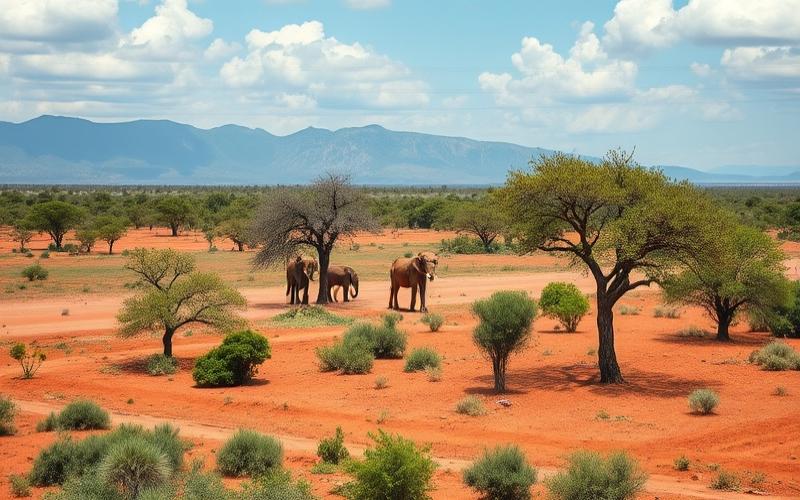
 Published on and written by Cyril Jarnias
Published on and written by Cyril Jarnias
South Africa, rich in biodiversity and varied landscapes, faces growing environmental challenges that require innovative and determined solutions. At the heart of these efforts are ambitious regulations and pioneering initiatives aimed at protecting its vital natural reservoirs while supporting sustainable development.
Policies structured around water resource management, wildlife conservation, and the reduction of polluting emissions demonstrate the nation’s commitment to integrating ecological concerns into its legislative framework. Exploring these dynamics offers insight into the complex balance between economic growth and environmental preservation in this resource-rich country.
Environmental Law in South Africa: Overview and Legal Framework
The history of environmental law in South Africa is marked by a profound transformation since the end of apartheid. Under the apartheid regime, environmental management primarily focused on supporting industrialization and disregarded ecological issues or the protection of vulnerable communities. Pre-1994 environmental laws, such as those on hazardous waste (1973) and pesticides (1947), continue to cause harm and human rights violations, perpetuating a legacy of “environmental racism” where marginalized populations were disproportionately exposed to pollution and polluting industries.
The democratic transition, beginning in 1994, represents a decisive turning point. The 1996 South African Constitution enshrines every citizen’s right to live in a healthy and protected environment, for the benefit of present and future generations. This foundational principle spurred the adoption of new laws and mechanisms aimed at ensuring citizen participation and strengthening environmental governance.
Key Legislative Developments:
- 1996 Constitution: guarantee of the right to a healthy environment and the state’s obligation to protect it.
- National Environmental Management Act (NEMA) (1998): fundamental framework law, establishing principles of integrated and participatory environmental management, as well as the requirement to assess the environmental impacts of any major project.
- Adoption of specific standards on chemicals and waste, aiming to address past gaps.
- Establishment of public participation mechanisms, especially for vulnerable groups, and strengthening of citizen roles in decision-making.
Table: Key Post-1994 Environmental Laws
| Year | Main Law | Impact on Environmental Management |
|---|---|---|
| 1996 | South African Constitution | Right to a healthy environment, intergenerational protection |
| 1998 | National Environmental Management Act | Integrated management, participation, EIA* |
| 2004 | Air Quality Act | Regulation of air pollution |
| 2008 | Waste Act | Modern waste management |
*EIA: Environmental Impact Assessment
The current legal framework is based on NEMA, which structures environmental management around principles such as public participation, prevention, responsibility, and integrated management. NEMA mandates the systematic assessment of projects likely to have a significant environmental impact and promotes transparency in decision-making. It is complemented by sectoral laws (air, waste, water management, etc.), aiming for a holistic approach.
Roles of Government Agencies:
Department of Environment, Forestry and Fisheries: central body responsible for policy implementation, standard development, monitoring, and compliance control with environmental laws.
Coordination with provincial and local administrations to ensure the legal framework is applied nationwide.
Significant influence in developing participatory mechanisms and managing natural resources.
List: Key Functions of the Department of Environment
- Development and updating of laws and regulations.
- Issuance of licenses and permits for impactful projects.
- Monitoring and inspection of industrial and extractive activities.
- Promotion of citizen participation and public consultations.
- Monitoring and publishing of environmental indicators.
Specific Challenges in Law Enforcement:
Biodiversity protection: habitat fragmentation, mining, land use conflicts.
Climate change: high dependence on coal, difficulties in energy transition, greenhouse gas emissions.
Natural resource management: water pressure, deforestation, overfishing, industrial pollution.
Persistence of discriminatory practices inherited from apartheid, especially in the siting of polluting infrastructure.
Initiatives to Strengthen the Legal Framework:
Public-private partnerships to promote energy transition (renewable energy, energy efficiency).
Ecological rehabilitation and restoration projects for contaminated soils.
Awareness and environmental education programs for communities.
Growing involvement of NGOs and civil society in monitoring law enforcement and defending environmental rights.
Development of participatory mechanisms to include vulnerable populations in decision-making.
List: Examples of Innovative Initiatives
- Support for sustainable agricultural cooperatives and agroecology.
- Creation of community nature reserves.
- Tax incentives for companies adopting green practices.
- Digital platforms for reporting and tracking environmental offenses.
The South African system, constantly evolving, aims to overcome the legacy of the past and build inclusive, effective, and resilient environmental governance, despite persistent structural and social challenges.
Good to Know:
The National Environmental Management Act (NEMA) transformed environmental management in South Africa by integrating sustainability principles, although challenges remain in enforcing these laws, particularly in biodiversity protection. Public initiatives like those from the Department of Environment and private actions play a crucial role in overcoming these obstacles and strengthening the existing legal framework.
Key Ecological Policies and Government Initiatives
South Africa has established a structured legal and policy framework for environmental management, with landmark laws and programs aimed at addressing the country’s major ecological challenges.
| Policy/Program | Main Objective | Date |
|---|---|---|
| National Environmental Management Act (NEMA) | Cooperative environmental governance, decision-making principles, institutional coordination | 1998 |
| National Water Act | Conservation, equitable sharing, and sustainable management of water resources | 1998 |
| Biodiversity Environmental Management Act | Conservation and sustainable management of biodiversity, benefit sharing | 2004 |
| National Air Quality Management Program | Monitoring and improving air quality, reducing pollutants | 2004 |
Government Initiatives and Major Programs:
- National Climate Change Adaptation Plan: aims to strengthen resilience to climate risks, integrate adaptation into sectoral policies, and reduce population vulnerability.
- Carbon emission reduction targets: South Africa committed to reducing its emissions under its Nationally Determined Contributions (NDCs), particularly through energy transition and renewable energy development.
- Innovative conservation projects: creation of community nature reserves, restoration of degraded ecosystems, sustainable management of indigenous wildlife and flora.
International Collaborations:
- Partnership with the European Union for funding water and biodiversity management projects.
- Participation in the Green Climate Fund and the Southern African Biodiversity Initiative.
- Cooperation with the United Nations Environment Programme (UNEP) for air quality monitoring and pollution control.
Challenges and Controversies:
- Difficulties in law enforcement due to lack of institutional and financial capacity.
- Conflict between economic development imperatives (mining, fossil fuels) and environmental protection.
- Persistent inequalities in access to clean water and a healthy environment, despite ambitious reforms.
- Controversies over the slow pace of energy transition and dependence on coal.
Future Prospects for Strengthening Environmental Policies:
- Strengthening environmental governance through better intersectoral integration and increased decentralization.
- Accelerating the transition to renewable energy and developing the green economy.
- Improving mechanisms for local community participation and benefit sharing from biodiversity.
- Strengthening adaptation and mitigation measures against increasing climate change impacts.
South Africa remains at a crossroads between ecological imperatives, social justice, and economic development requirements. Consolidating legal frameworks and innovation in partnerships will be crucial to addressing future environmental challenges.
Good to Know:
The 1998 National Environmental Management Act and the National Air Quality Management Program in South Africa are reinforced by initiatives like the National Climate Change Adaptation Plan, although controversies persist, particularly regarding the pace of achieving carbon emission reduction targets and international collaborations. Furthermore, innovative projects, such as those for biodiversity conservation and natural resource management, illustrate the country’s growing commitment despite persistent regulatory challenges.
Comparison of Regulations with the European Union
Key Environmental Regulations – South Africa vs European Union
| Theme | South Africa | European Union |
|---|---|---|
| Biodiversity Protection | Integrated environmental management laws (NEMA), regulations on marine wildlife transfers, protection of the African penguin. | Habitats Directive, Birds Directive, Natura 2000, biodiversity strategies for 2030. |
| Natural Resource Management | Water regulations, coastal management, fishing quotas, investments in renewable energy (solar, energy storage). | Water Framework Directive, integrated resource management, European Green Deal, circular economy objectives. |
| Pollution Control | Oil pollution act (OPRC integration), control of fuel transfers at sea, waste management. | Air Quality Directives, REACH (chemicals), plastic regulation, strict industrial emission standards. |
| Climate Policies | Hydrogen Society Roadmap, green hydrogen directive, REIPPPP for green energy, coal reduction. | European Green Deal, 2050 carbon neutrality goals, ETS (carbon market), adaptation and mitigation policies. |
Similarities in Regulatory Approaches
- Priority on energy transition and carbon emission reduction (South Africa: massive investments in solar and green hydrogen; EU: Green Deal, carbon neutrality).
- Biodiversity protection through specific laws, creation of protected areas, and involvement of local stakeholders.
- Adoption of international standards (South Africa: integration of OPRC conventions on marine pollution; EU: alignment with international standards and UN conventions).
Major Differences
- The EU applies more uniform and binding standards at the supranational level, with strict sanction and control mechanisms (e.g., carbon quotas, harmonized directives).
- South Africa adapts its laws to local economic needs (e.g., balance between maritime exploitation and wildlife protection, support for the blue economy).
- The EU has aid funds and a carbon market, whereas South Africa relies on direct investment and international cooperation to fund its transition.
Specific Areas: Concrete Examples
Biodiversity Protection
- South Africa: New regulations to limit fuel transfers near coasts to protect the African penguin and marine life.
- EU: Creation of Natura 2000 sites, ban on certain pesticides, ecosystem restoration.
Natural Resource Management
- South Africa: Deployment of solar projects (1,760 MW), modernization of the electrical grid.
- EU: Water Framework Directive, strategy for forest and soil restoration.
Pollution Control
- South Africa: Draft bill on oil pollution, involvement of local communities and NGOs.
- EU: Directives on air and water quality, gradual ban on single-use plastics.
Climate Policies
- South Africa: Roadmap for green hydrogen, policy to reduce coal use.
- EU: Carbon neutrality goal by 2050, carbon border tax, green pact.
Potential Economic and Social Impact
South Africa
- Job creation in the green sector (solar, hydrogen).
- Social risk in coal-dependent regions.
- Valuation of the maritime economy and protection of local livelihoods (fishing, tourism).
- Need for support for communities affected by energy transitions.
European Union
- Stimulation of innovation and green sectors (jobs, competitiveness).
- High adaptation costs for some industrial sectors.
- Social safety nets and transition funds to limit negative impacts.
- Increased pressure on imports from third countries via strict environmental standards.
South Africa – EU Collaborations and Partnerships
- Partnerships for energy transition: funding South Africa’s transition via European funds, sharing expertise on carbon markets.
- Cooperation on biodiversity protection and marine pollution control: exchange of best practices, technical support.
- Dialogue within the framework of the Paris Agreement and G20 on climate policies and decarbonization.
| Key Points of Convergence | Points of Divergence |
|---|---|
| Common global sustainability and climate protection goals | Stricter and more uniform regulatory constraints in the EU |
| Technological and financial cooperation | More pragmatic and adaptive approach in South Africa |
| Gradual integration of international standards | Stronger dependence on fossil fuels in South Africa, ongoing transition |
South African environmental regulations are gradually converging towards European standards but remain marked by pragmatism linked to local economic and social issues. Collaborations with the EU play a key role in accelerating this convergence, particularly through the transfer of green technologies and funding for the energy transition.
Good to Know:
South Africa and the European Union share common approaches to biodiversity protection but differ on pollution standards, with the EU being stricter; partnerships, such as those on renewable energy, aim to harmonize certain climate policies. Joint initiatives, like funding programs for climate change combat, illustrate the potential positive economic and social impact of these collaborations.
Impact of Environmental Laws on Expatriates
Key Environmental Laws in South Africa and Impact on Expatriates
- Climate Change Law (2024): imposes emission caps on major emitters, requires adaptation plans for each municipality and sector (agriculture, industry, transport). Each high-emitting company receives a carbon budget not to be exceeded.
- Draft Oil Pollution Bill: integrates international OPRC provisions regarding prevention and management of marine oil pollution. Mechanisms for rapid response and compensation are provided in case of incidents.
- Land Laws: the state can expropriate or requisition land for public interest, particularly for environmental or social projects. Affected landowners must be consulted.
| Law/Obligation | Direct Impact for Expatriates | Sectors Affected |
|---|---|---|
| Emission Caps | Comply with limits in their company or residence; lifestyle adaptation | Industry, transport |
| Municipal Plans | Participation in selective collection or local waste management | Residential |
| Oil Pollution | Strict compliance during nautical/industrial activities; mandatory reporting | Maritime, petroleum |
| Land Expropriation | Legal follow-up if owner; mandatory consultation | Real estate |
Specific Legal Obligations
- Selective sorting and responsible treatment of household waste.
- Strict limitation of polluting emissions in professional contexts.
- Compliance with local standards for rational use of water and electricity.
- Mandatory reporting in case of ecological incidents involving professional or personal activities.
Consequences on Lifestyle and Work
- Necessary adaptation to local ecological practices (advanced sorting, plastic limitation).
- Investment in clean technologies (electric/hybrid cars recommended).
- Possible participation in energy or ecological audits organized by municipalities/employers.
Local Initiatives Accessible to Expatriates
Non-exhaustive list:
- Municipal programs to clean beaches/rivers
- Educational workshops on local biodiversity
- Citizen associations like BirdLife South Africa or Green Connection
- Urban shared gardens promoting sustainable agriculture
Role and Challenges for International Companies
Foreign companies must:
- Strictly comply with the national emission cap set by sector
- Regularly develop their internal carbon reduction plans
- Implement active regulatory monitoring in an evolving framework
Main challenges encountered:
- Increased administrative complexity related to local environmental reporting
- Frequent need for additional technological investments
- Slow coordination with multiple government agencies during major incidents
Opportunities Offered to Expatriates
Summary list:
- Actively participate in the energy transition via local professional associations
- Propose sustainable innovations adapted to the South African context
- Join local networks dedicated to sustainable development (e.g., “green business” forums)
- Engage in community projects promoting social inclusion & environmental protection
Scrupulously respecting these laws not only ensures successful integration but also a direct contribution to South African sustainable development.
Good to Know:
Expatriates in South Africa must comply with strict laws on carbon emissions and waste treatment, with local initiatives available like community recycling programs where they can actively engage. International companies must adapt their operations to minimize environmental impact, which can sometimes be complex but also offers opportunities to innovate in sustainability.
Disclaimer: The information provided on this website is for informational purposes only and does not constitute financial, legal, or professional advice. We encourage you to consult qualified experts before making any investment, real estate, or expatriation decisions. Although we strive to maintain up-to-date and accurate information, we do not guarantee the completeness, accuracy, or timeliness of the proposed content. As investment and expatriation involve risks, we disclaim any liability for potential losses or damages arising from the use of this site. Your use of this site confirms your acceptance of these terms and your understanding of the associated risks.
























































